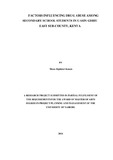| dc.description.abstract | This study sought to examine the factors that influence alcohol and drug abuse
among secondary school students in Uasin Gishu East Sub County. Alcohol and drug
abuse poses a major public health problem in Kenya with consequences ranging from
poor health to reduced economic productivity. Kenyan youth, a large proportion of
whom is secondary school students face the greatest risk as they are targeted for
recruitment into substance use by drug peddlers. There is a dearth of data on
knowledge, attitude and practice regarding alcohol and drug use, as well as how
various factors influence drug abuse among secondary school students in Uasin Gishu
East Sub County, Kenya. This study sought to describe the factors that influence use
of drugs, prevalence of drug use, and the knowledge of and attitude towards drug use
among secondary school students in Uasin Gishu East Sub-county. The study
objectives were to examine the social, economic, environmental and technological
factors influencing drug abuse in Uasin Gishu East Sub County. The influence of
knowledge and attitude regarding drug abuse was also explored. The research
questions for which answers were sought in this study are; to what extent do social
and economic factors influence drug abuse among secondary school students in Uasin
Gishu East Sub County, what are the effects of environmental factors on drug abuse
among secondary school students in Uasin Gishu East Sub county, and to what extent
do media and technological factors influence drug abuse among secondary school
students in Uasin Gishu East Sub county. The descriptive research design was
adopted in this study. Data was collected from randomly selected teachers and
students using interview schedules and self-administered questionnaires respectively.
Multi stage random sampling and convenient sampling design were used to select
student and teacher respondents respectively. Data were analysed using the statistical
package for social sciences (SPSS) version 21. Measures of associations were
calculated using Chi Square at 95% confidence level and conclusions drawn. The
study found out that socially, there is a positive relationship between a student’s drug
abuse and; drug abuse by family member, drug abuse by best friend, and highest
educational level of parents/ guardian. On the economic front, it was found out that
there was a positive correlation between the amounts of pocket money a student
received per term and drug abuse, and there was a statistically significant association
between abuse of drugs and whether the parent/guardian owned a motor vehicle. The
odds of a student taking any drugs were 2 times higher if their parent/guardian owned
a motor vehicle, urbanite students were more prone to drug abuse than their rural
counterparts, and the odds of a student taking any drugs were 4 times higher if they
had access to the internet. The researcher recommends that measures be put in place
to enforce existing laws governing drug sector, school curriculum be enriched to
better handle drug abuse, and more research to be done to ascertain the long term
effects of drug abuse in relation to age of onset of drug use. | en_US |

